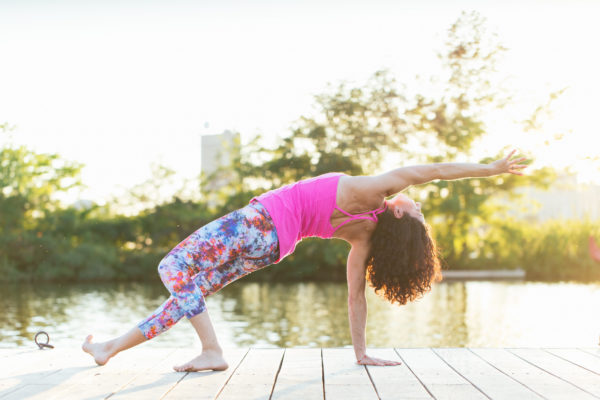
There are always parts of the practice I’m refining when it comes to the cues that I say to communicate the key actions of the pose. As I teach, as I’m sure you do if you’re a yoga teacher, I say something and then watch for what happens. If there’s a lot of confusion, of course I know the cues didn’t work. If there’s clear action in the right direction, I know that’s a keeper.
One of the sections of the sequence that is particularly challenging to cue is backbends, both those that we do on the belly (like Locust and Bow) and those that we do on the back, like Wheel. There are a few reasons why they are challenging both to cue and for students:
- There are quite a few key actions to take so as a teacher it’s hard to know what specific things to focus on
- For students, backbends on the belly are easy to overdo in the neck (cervical spine) and we tend to forget moving through the shoulders and chest (thoracic spine)
- For backbends on the back, they require a good combination of strength and length and many students are compromised in these areas
- As a teacher it can be hard to know what key actions to suggest in backbends on the back because there is so much going on in the pose.
If we think anatomically, there are some challenges many people face as they try to do a backbend in either position (on the belly or back):
- Tight hip flexors like the psoas
- Difficulty distinguishing between moving the neck and moving the shoulders and chest/overdoing moving through the neck because it’s just that much more mobile
- A lack of upper body strength
- Weakness in the wrists (sometimes due to overuse injuries or overuse habits like typing on a computer)
- Weakness in the internal rotators of the leg and therefore and overcompensation in Wheel of turning the feet out (which compresses through the SI joint/lower back).
There is a LOT to backbending and I’m not going to get into every aspect of it here. I am going to suggest a few cues you can try to see how they work with your classes.
Consider:
Suggest in Locust Pose that students keep the gaze point straight ahead but not up to the ceiling or down to floor. This will keep the head only slightly higher than the shoulders
- Suggest in Locust Pose that students, while keep the arms by the sides, draw the shoulder blades together. This will contract the rhomboids and start to build strength in those muscles that are overly stretched from hunching over the phone/computer
- Suggest in Bow Pose that they primarily focus on the action of pushing the feet back into the hands. Bow is a neat pose in that there’s really one key action the student needs to do to create the pose… that is “push the feet back.” The rest follows from there. Yes, we need to watch that the knees don’t splay out (compressing the SI joint) but the main piece is “push the feet back.” As they do this, gently warn them to stay alert as to how much they push as it can strain the shoulders.
- Suggest in Wheel that they start with a block between the thighs or even one at their feet, between their feet, perpendicular to the feet. Both of these will allow them to strengthen the internal rotators of the thighs and prevent the external rotation at the ankles and hips. This is a secondary function of the gluteus maximus that we want to avoid in Wheel because (you guessed it!) it compresses through the SI joint.
- Suggest in Wheel that they lift their heels. This allows more freedom of movement in the pelvis so they can get more “up” in the pose.
These are some cues you can try and watch and see what happens. Backbends can be a challenge for all the reasons I mentioned above (and others) so it’s really a matter of saying and then watching what happens.
For more on cues, check out my free webinar on YOGA CUES by clicking here.Â
If you’re interested in MORE information about the hips and backbending, my course called LEARN THE ANATOMY, PRACTICE IT, TEACH IT, has a whole section on that. The course is $79 but if you send me an email and mention this blog post, I’ll give you a coupon code for $20 off. Here is the link to the course where you can see reviews and look at a preview. (pick the specific course on the page w/ the above name). Click here.Â
Thanks for reading and I’d love to hear what you think in the comments!
